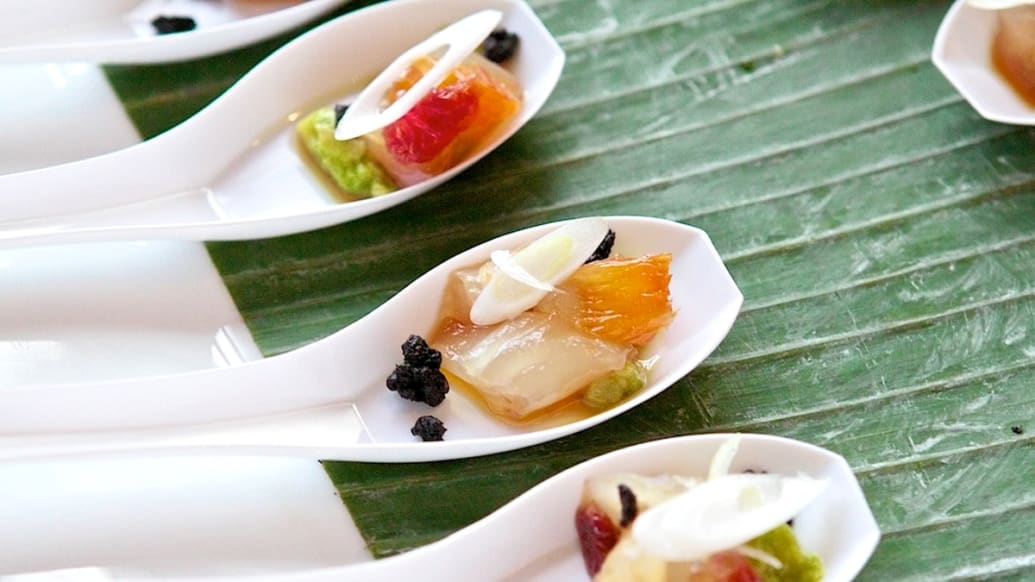Since the California roll made its way to the U.S. in the mid-1980s, the popularity of Asian food has been on the rise stateside. Today, you can find sushi everywhere from grocery stores to $1,000-a-plate fine-dining establishments. Entire sections of Whole Foods are even dedicated to Asian cuisine.
“It’s the zeitgeist,” said Danielle Chang, founder of Luckyrice. “In recent years, the understanding and appreciation for Asian culture has grown by leaps and bounds, and I think it’s due to the influence of increased trade and travel between Asia and the U.S.”
The 2012 Luckyrice Festival, running May 1 to 6 in New York City—and expanding to Los Angeles and Las Vegas this summer—is now in its third year and features a dazzling array of chefs preparing some of the most beautiful, mouthwatering creations Asian cuisine has to offer.
But how did Asian food manage to capture the appetites of Americans? On the eve of the festival, The Daily Beast discussed the Asian-food explosion with five all-star chefs: Masaharu Morimoto (Morimoto), Eric Ripert (Le Bernardin), David Chang (Momofuku), Todd English (Olives), and Ming Tsai (Blue Ginger).
The Forefathers
Ripert: Joël Robuchon was one of the first chefs to come back to France very influenced by Japanese cuisine and culture, and he integrated into French cuisine, which was very classic in style, some Japanese ingredients and techniques. It was very subtle, but it gave an edge to his cuisine, and the press was really surprised in France at the time, and this was in 1981–82.

Tsai: East-West cuisine like Lespinasse back in the day, Union Pacific, etc., had all the fine-dining elements but really featured Asian ingredients. But you really do have to go back 20 years to France with Robuchon. Even Mario Batali plays around with soy. They call it “New French” or “New American,” but they’re all using ginger and sesame and soy sauce and lime leaf, and a lot of the techniques are Asian.
Chang: People became better-traveled and well aware of what’s going on in the world. And two chefs that were instrumental in introducing Asian flavors in America were Jean-Georges and Greg Koontz. These guys worked in Thailand, Singapore, and Hong Kong and brought the flavors back. That was the snowball that turned into the avalanche, because those cooks influenced an entire generation of cooks.
Morimoto: When I came here in 1985, I wanted to see what the American palate was like. I worked at restaurants where all the customers were Japanese. But Barry Wine was very understanding of both Japanese cuisine and Japanese fish, so he kind of pioneered this East-West cooking style.
‘Asian Fusion’
English: There was an influence of not-so-good Asian food in the beginning, and it was considered “ethnic” and “Sunday night out” and cheap and sticky. I use to call it “lollipop sauce.” Because of the fusion, we started seeing a transition to the palate, and to education, and to understanding that ginger was the new garlic, so to speak. Red Farm does a great job at putting together Chinese dishes in a very healthy way. I think we got a very bastardized version of Chinese food for a long time here—the sticky, goopy, China Buffet version—and now you have places that are doing really authentic things.
Chang: I don’t really look at what we do as Asian. Most of my training is French. I don’t know what isn’t “fusion.” I know there’s a genre of “fusion” that came out of the ’90s, but everything is fusion. But categories are what people feel comfortable with. Instead of having categories of food, people should be asking themselves: “What is most delicious?” Nobu is a perfect example. It sounds like a terrible idea on paper—Peruvian-Japanese? But it makes sense. It’s accepted because it’s delicious, and it’s honest in the way they’re putting flavors together.
Morimoto: I don’t like the word “fusion,” because it’s like I always say: “Fusion is confusion!” My food isn’t really fusion, but more of my interpretation of global cuisine.
Ripert: I like the term. And 15 years ago, we started to see many restaurants that were not really upscale mixing Japanese with Western food in a cheap way. It gave “fusion” a bad name. But look at Jean-Georges. When he opened Vong, which was a Thai restaurant, it was a fusion restaurant because it had a lot of French influences.
Tsai: I do caution, because some of the worst food I’ve ever had in the world is bad fusion cuisine. I call it “con-fusion cuisine.” One thing we never do is East-East, so I never combine Japanese with Korean, or Thai with Chinese. It’s too strong a flavor!
Ingredients
Morimoto: One of the reasons that the East-meets-West concept became so popular is the development of transportation. Now Asian ingredients are readily available, which makes it easier to make this sort of food. I can get Japanese fish from Tokyo much, much easier than before.
Ripert: You find a lot of Asian preparations already made, like the sauces are already made in a bottle, so it makes the process very simple. And the Asians really mastered how to integrate sweetness in their food, and the American palate likes sweetness. I think the American palate also likes powerful flavors and spicy food, which are big parts of Asian food.
Health and Wellness
Tsai: The ratio of vegetables to meat to starch is much higher. Eighty-five percent of the food markets in Beijing are vegetables, which are delicious and good for you. Braising, steaming, wok stirring—these are healthy ways to cook. There isn’t a lot of butter and cream, and your fat comes from meat, but a lot of times, the protein is used for flavoring and isn’t at the center of the plate like a rib eye.
English: Yes, people want big flavor without the fat, and cooked properly, Asian food can do that. The food is very vegetable- or protein-driven.
Morimoto: You can eat sushi everywhere, in every single corner. I think it started because people started thinking that it keeps you healthy—The New York Times wrote an article about how healthy it is.
Ripert: It’s not like pizza or pasta, that’s for sure! Asian food has a reputation for being much lighter than European cuisine, so you can still go to a party after.
Cooking Shows
Ripert: The TV shows have had a huge impact. If people watch it at home, they have a huge curiosity to try that food. If you look at 30 years ago, there were very few Japanese restaurants in the U.S. Today they are everywhere.
Morimoto: Iron Chef helped me a lot. When I did Iron Chef in Japan, a lot of kids who watched wanted to become chefs. Then, I did the American Iron Chef, and a lot of people watching on TV wanted to become chefs here. By the time Iron Chef finished about 10 years ago in Japan, the Japanese food industry had really expanded.
Tsai: I’ve been on the Food Network for quite some time, but cooking shows really popularized restaurants in general. My goal with East Meets West and Simply Ming was to demystify Asian ingredients and preparation.
Fine Dining
Morimoto: Japanese food became the fashion. A lot of movie stars began having lunches and dinners at Japanese restaurants.
Ripert: When you talk about Chinese food, very often you think about takeout. But many of the ingredients you find in Chinese restaurants are very interesting as far as texture and flavor, and therefore, they can be integrated into fine dining, and people will pay a premium for it. The perception today has changed, and people are willing to pay the price. People are willing to spend $200–$300 for dinner for two at a sushi restaurant.
Tsai: What has never really made it in this country, however, is a fine-dining Chinese restaurant, like the ones that are $1,000 a head in Beijing, because some of the ingredients are taboo, like shark’s fin. I would use bird’s nest, but bird’s nest is 10 times more expensive than black truffles. Americans don’t understand or appreciate the value, textural difference, and incredible healthy benefits of bird’s-nest soup, so they’re never going to pay $1,000 for a bowl of soup here. Americans also aren’t into eating bear’s paw or sea cucumber, so it’s a different culture.
Chang: At the end of the day, the litmus test is that it’s really delicious. [Momofuku] is not considered a ‘fine dining’ restaurant like the Per Se’s, Daniel’s, or Le Bernardin’s, but we still hold ourselves to the highest standards with whatever we’re serving.
The Future
English: I think it’s here to stay—especially the healthier aspect of it and using less fat.
Tsai: There’s a big shift involving wellness and health. Before drugs, it was food that kept you healthy, so by eating tofu, soybeans, and drinking red wine, you probably won’t get cancer. The trend is coming back, and people are realizing that you are what you eat, and food is the next medicine. People want to remain healthy, and obesity is the No. 1 disease that’s going to destroy this world, so that’s going to keep Asian food popular.
Morimoto: Now the yen currency rate has changed, so ingredients from Japan have become very expensive. The Chinese here have their own community, so they make their own ingredients and can get them. However, I don’t know if another sushi boom will happen. People get bored easily, so we should try our best to keep our businesses going forward. I don’t think the American palate is changing a lot, and I think we should focus on health and safety. And I think sushi will go more reasonable and more high-end, but I don’t think the people in the middle can survive.
Ripert: I think it’s going to be more “fusion” to the point where we won’t know whether it’s Chinese or Thai or Mandarin. Chefs are going to use more and more of those ingredients and techniques. The next trend is going to be Asian food in the streets. I don’t know how many years it’s going to take, but we’re going to see that soon.

